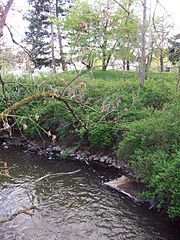Winning stick
| Winning stick | ||
|---|---|---|
|
Today's remains of the moth, view from the north |
||
| Alternative name (s): | castrum in Sualheim (1282/83), borgk in Swalheim, Gewanekippel, Gewannekippel | |
| Creation time : | approx. 10th century (documented in 1282/83) | |
| Castle type : | Niederungsburg, moth | |
| Conservation status: | Burgstall | |
| Standing position : | unknown | |
| Place: | Bad Nauheim - Schwalheim | |
| Geographical location | 50 ° 21 '20.5 " N , 8 ° 45' 36.9" E | |
| Height: | 133 m above sea level NN | |
|
|
||
The Gewanneküppel is the remainder of a low castle that was built in the transition from the early to the high Middle Ages , designed as a tower hill castle (Motte) in Schwalheim , today a district of Bad Nauheim in the Wetterau district in Hesse .
location
The Burgstall is located west of the center of the village between the sports field and the weather , which flows here in a loop to the west.
history
There is hardly any documentary information about the moth . Since it is close to a weather crossing on the Salt Road , which ran from the Nauheimer Saline via Echzell towards Central Germany , and passed between the former bridge mill and the Gewanneküppel, it can be assumed that the Niederungsburg was built to secure trade and road tolls at the river crossing . The trade route was soon moved to the right side of the weather and the security castle was no longer important. It fell into disrepair and was never built into a stone castle. Based on the excavations and the structure of the moth, it can be concluded that it was built in the 10th century. The exact date of construction is not known and there is only one piece of news from the end of the 13th century, in which the castrum in sualheim or borgk in Swalheim is mentioned as owned by the Lords of Eppstein as a fiefdom of the Counts of Loon.
In 1949 the complex was excavated and ceramic shards , metal parts, wood remains and bones were recovered, which were dated to around 1300. The structure of the plant could be largely determined.
In 1954 and 1973, parts of the facility were removed when the road and the sports field were built.
description
A moth in an approximately round embankment and today around 40 meters in diameter on the Schwalheimer Wettererschleife is called a "Gewanneküppel". Archaeologically, it is interpreted as a typical form of a presumably Ottonian residential castle made of wood. The embankment, which is only shallow today, is said to have been around four meters high. Since the soil was washed away more and more after the facility fell into disrepair, the residents of the village had solidified the facility with pieces of lawn or plants, popularly known as "tub", which led to its current name.
There are no visible building remains apart from the castle hill. From the structures of such a moth known to us, it can only be concluded that there was a stone basement with a half-timbered construction as the upper floor. According to Karl August von Cohausen's notes , the motte had a double palisade fence with a moat in front and a wall in front of it.
In the 19th century, the moat is said to be still functional and filled with water from the nearby weather. It was later filled in and leveled.
Todays use
The Burgstall is now a cultural monument as part of the entire Schwalheim complex (see also the list of cultural monuments in Bad Nauheim ). On site, a display board explains the most important information as part of the city history tour.
literature
- Rudolf Knappe: Medieval castles in Hessen. 800 castles, castle ruins and fortifications. 3. Edition. Wartberg-Verlag, Gudensberg-Gleichen 2000, ISBN 3-86134-228-6 , p. 325f.
Web links
- State Office for Monument Preservation Hessen (Hrsg.): Gewanneküppel In: DenkXweb, online edition of cultural monuments in Hessen
- Gewanneküppel Castle, Wetteraukreis. Historical local lexicon for Hesse (as of February 17, 2014). In: Landesgeschichtliches Informationssystem Hessen (LAGIS). Hessian State Office for Historical Cultural Studies (HLGL), accessed on May 2, 2014 .
- Entry for Gewanneküppel in the private database "Alle Burgen".
Individual evidence
- ↑ The feudal rights of the Counts of Loon, given in Knappe, p. 326 are unclear, perhaps County Loon ? Transcribed from the Eppstein fiefdom directory actually reads as follows: "Vome grafen von Loen: Item from eym grafen von Loen die borgk in Swalheim with all sym zcugehore and ...." from Eppsteiner fiefdom directory repertories of the Hessian State Archives Darmstadt : C 1 B No. 26: Eppsteiner Lehenbuch im Fürstl. Stolberg Archive in Roßla
- ↑ the date on the display must be wrong, AvC died in 1894







